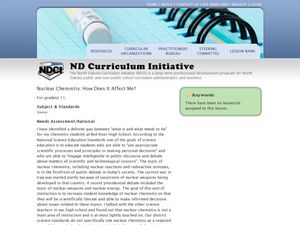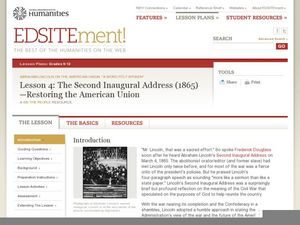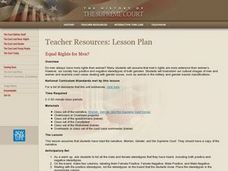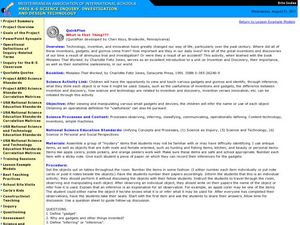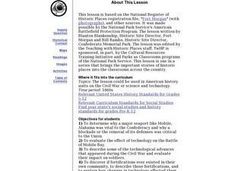Curated OER
Some Ways to Integrate Trade, the "Missing Link" into Ancient History
Ninth graders examine the importance of trade in the Mediterranean Sea. In groups, they create a chart of the items that were most popular in the late Bronze Age and where they originated. To end the lesson, they read an article out of...
Curated OER
Analysis of the Pontcysyllte Aqueduct
Students examine primary resources to analyze pictures and documents related to the Pontysyllte Aqueduct (built by Thomas Telford) in Britain. In this critical-thinking lesson plan, students answer questions based on primary source...
Curated OER
The Prospect of Democracy in Iran
Young scholars investigate the Iranian presidential election of 2009. In this world affairs lesson plan, students explore the evidence of democratic values in Iran and consider how the public demonstrations following the elections were...
Curated OER
Nuclear Chemistry: How Does It Affect Me?
Eleventh graders study the different areas of nuclear chemistry. In this energy and critical thinking instructional activity students study radiation, nuclear energy and weapons then divide into groups and create a poster.
Curated OER
Reagan and Bush: The Conservative Years
Students investigate the conservative agenda of the Republican Presidents Ronald Reagan and George Bush. They conduct Internet research, evaluate an edition of the Wall Street Journal, and write and publish a special-edition newspaper...
Curated OER
Constitutional Issues: Watergate and the Constitution
Students take and defend positions on what conditions contribute to the establishment and maintenance of a constitutional government. They debate whether or not the government should have prosecuted Nixon over the Watergate scandal.
Curated OER
The Berlin Airlift
Students examine a document from the Berlin Airlift in order to research his important event in World History.
Curated OER
The Decision to Go to War
Learners examine President Bush's decision to go to war with Iraq. They work together to discuss a topic related to this given to them by their teacher. They answer questions to complete the lesson.
Curated OER
Brutal British
Students read and predict the outcome of a story set during the Civil War, then map the story. To prepare for the activity, students determine why it is important to look at historical events from all angles by using primary and...
Curated OER
The Second Inaugural Address (1865)—Restoring the American Union
Students explore the content of Abraham Lincoln's Second Inaugural Address. In this Abraham Lincoln lesson, students analyze the text of the speech to determine how Lincoln sought to reconstruct the country as the Civil War drew to a close.
Curated OER
International Response to Child Labor Issues
Students examine effectiveness of international response to child labor problems. Students describe problem as international community sees it, evaluate analysis and response tactics of International Labor Organization, and determine...
National Park Service
Nutcracker Fantasy
The Clark's nutcracker bird hides seeds in 25,000 different sites every year to save for winter. Lesson demonstrates how difficult it would be to find these seeds months later when they need them for food. In the first of five lesson,...
Curated OER
Equal Rights for Men?
Study the issue of gender bias in court cases with a resource that ponders the extent of gender equality. Learners examine cultural images of men and women and examine court cases dealing issues such as women in the military.
Curated OER
What Is That Thing?
Could your class identify an old-fashioned can opener? What about a rotary phone, or a VCR? Learners take a look at several gadgets and devices to infer the name and purpose of each item.
Curated OER
FDR Fireside Chat
Eleventh graders examine the purpose of Franklin D. Roosevelt's chats. In this American History lesson, 11th graders collaborate with their group members on becoming an expert on a specific chat.
Curated OER
Fort Morgan
Pupils investigate how Mobile, Alabama was significant to the Confederacy during the Civil War. They analyze maps, read primary source documents, write a research paper on Civil War military technology, and explore the Fort Morgan website.
Curated OER
Election of 1860
Young scholars determine how the presidential election of 1860 led to the American Civil War. In this election of 1860 lesson, students discover details regarding the election and hold their own mock debate and election. Young scholars...
Curated OER
The Civil War in Art and Literature
Students examine art related to the Civil War. They participate in activities that allow them to write poetry and drawings. They create their own journal and collect their work in a binder.
Curated OER
The New Frontier and the Great Society
In this 1960s American history worksheet, students identify the 7 terms that best match 7 descriptions, eliminate 3 false statements, and identify 2 historical themes pertaining to Kennedy's new frontier and Johnson's Great Society.
Curated OER
The First World War
In this World War I worksheet, students review a chapter as they match 5 men to their accomplishments, read 5 false statements then make them true, and identify 2 historical themes pertaining America's role in the war.
Curated OER
We the People... How Does Government Secure Natural Rights?
Students investigate the Founders' ideas about what kind of government is most likely to protect the basic rights of people. They distinguish between limited and unlimited government.
Curated OER
War, What is it Good for?
Eighth graders examine aspects of the American Civil War related to West Virginia. In this research skills lesson, 8th graders collaborate to research Civil War topics and create electronic portfolios that feature their findings.
Curated OER
It Wasn't a Bullet
Students explore U.S. history by researching disease in class. In this Civil War injury lesson, students identify the different causes of death most soldiers faced while fighting in the war. Students role-play and write a diary entry as...
Curated OER
What Happened to Slaves When their Owners Died?
Young scholars analyze last and testaments of former slaveowners to identify and explain economic, social and cultural differences between the North and the South leading up to the Civil War.





